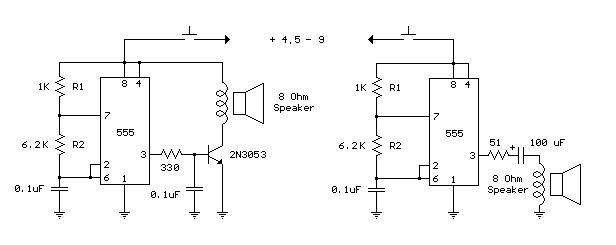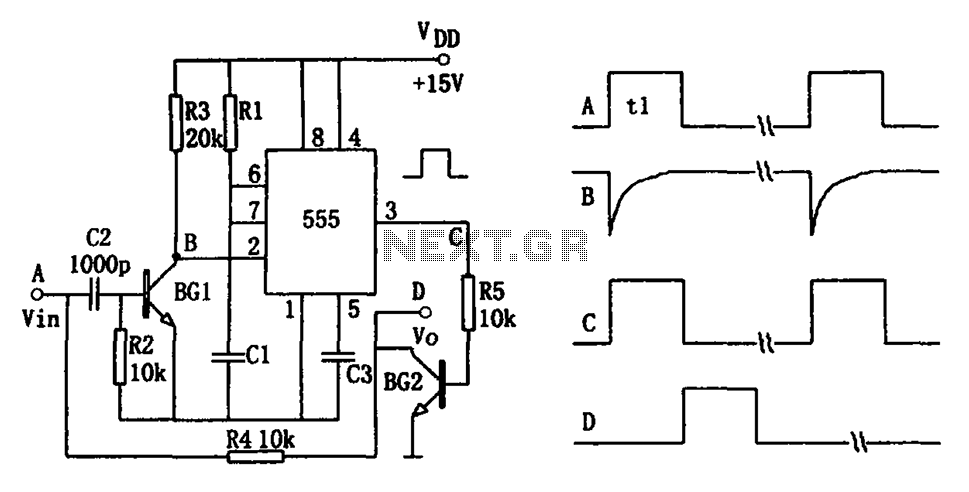
HV Ignition Coil Driver using 555

A simple design based on a 555 to drive a car ignition coil. This was designed for a small electric fence to protect a vegetable garden from small animals called marmots. Last year, they ate one of the crops entirely before the installation of this device. A few shocks and no more problem. The garden is on raised beds, and the high voltage wire is just 3 inches above the wood frames on homemade PVC pipe insulators. This design could be quite useful for persons that have rabbit problems as well, with the wire raised a bit higher. However, a warning is provided below. Definitely makes a strong electric fence. However, because it is a continuous pulse output,
WARNING: This can kill smaller animals, such as cats and rabbits, and probably even small children! For a much safer electric fence, please consider making the "C-Mos Fencer" project. However, this car coil design can have many other uses as a high voltage supply.
This circuit utilizes the popular 555 timer IC in astable mode to generate a continuous pulse output. The 555 timer is configured to oscillate at a frequency that is suitable for driving a car ignition coil, which is capable of generating high voltage. The output of the 555 timer is connected to the primary winding of the ignition coil, causing it to produce a high-voltage pulse at its secondary winding.
The design includes a few key components: resistors and capacitors that determine the frequency of the oscillation, as well as a diode to protect the circuit from back EMF generated by the ignition coil. The output voltage from the secondary winding can reach thousands of volts, which is sufficient for creating an electric fence that deters animals from entering the protected area.
The high voltage wire should be securely mounted 3 inches above the ground using homemade PVC pipe insulators, which will prevent unintended grounding and ensure effectiveness. It is crucial to follow safety precautions when working with high voltage circuits, as improper handling can result in serious injury or death, particularly to small animals and children.
While the design is effective for deterring small animals, it is imperative to consider alternative designs, such as the "C-Mos Fencer," for a safer electric fence solution. This circuit can also be repurposed for other applications requiring a high voltage supply, making it a versatile addition to an electronics engineer's toolkit.A Simple design based on a 555 to Drive a Car Ignition Coil. I Designed this for a Small Electric Fence to Protect my Vegitable Garden from some Small Animal called a Marmots. Last year they ate one of my crops entirely before I could install this device. A Few Shocks and No More Probem. My Garden is on Raised beds and the High Voltage wire is just 3 inches above the wood frames on homemade PVC Pipe Insulators.
Could be Quite useful for persons that have Rabbit Problems also, with the wire raised a bit higher, But Read Warning Below. Definately Makes a STRONG Electric Fence. However, because it is a Continuous pulse output, WARNING: This can Kill Smaller animals, such as cats and rabbits, And Probably Even Small Children! For a Much Safer Electric Fence, PLEASE consider making the "C-Mos Fencer" Project. However this Car coil design can have many other uses as a HV Supply. 🔗 External reference
WARNING: This can kill smaller animals, such as cats and rabbits, and probably even small children! For a much safer electric fence, please consider making the "C-Mos Fencer" project. However, this car coil design can have many other uses as a high voltage supply.
This circuit utilizes the popular 555 timer IC in astable mode to generate a continuous pulse output. The 555 timer is configured to oscillate at a frequency that is suitable for driving a car ignition coil, which is capable of generating high voltage. The output of the 555 timer is connected to the primary winding of the ignition coil, causing it to produce a high-voltage pulse at its secondary winding.
The design includes a few key components: resistors and capacitors that determine the frequency of the oscillation, as well as a diode to protect the circuit from back EMF generated by the ignition coil. The output voltage from the secondary winding can reach thousands of volts, which is sufficient for creating an electric fence that deters animals from entering the protected area.
The high voltage wire should be securely mounted 3 inches above the ground using homemade PVC pipe insulators, which will prevent unintended grounding and ensure effectiveness. It is crucial to follow safety precautions when working with high voltage circuits, as improper handling can result in serious injury or death, particularly to small animals and children.
While the design is effective for deterring small animals, it is imperative to consider alternative designs, such as the "C-Mos Fencer," for a safer electric fence solution. This circuit can also be repurposed for other applications requiring a high voltage supply, making it a versatile addition to an electronics engineer's toolkit.A Simple design based on a 555 to Drive a Car Ignition Coil. I Designed this for a Small Electric Fence to Protect my Vegitable Garden from some Small Animal called a Marmots. Last year they ate one of my crops entirely before I could install this device. A Few Shocks and No More Probem. My Garden is on Raised beds and the High Voltage wire is just 3 inches above the wood frames on homemade PVC Pipe Insulators.
Could be Quite useful for persons that have Rabbit Problems also, with the wire raised a bit higher, But Read Warning Below. Definately Makes a STRONG Electric Fence. However, because it is a Continuous pulse output, WARNING: This can Kill Smaller animals, such as cats and rabbits, And Probably Even Small Children! For a Much Safer Electric Fence, PLEASE consider making the "C-Mos Fencer" Project. However this Car coil design can have many other uses as a HV Supply. 🔗 External reference





